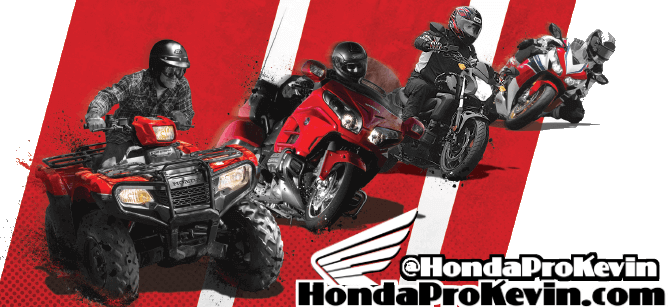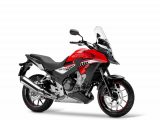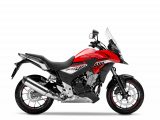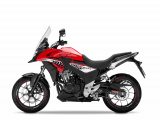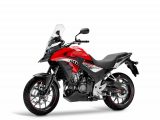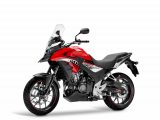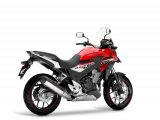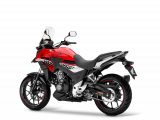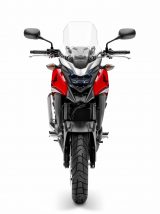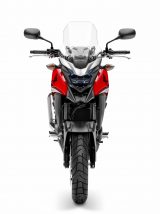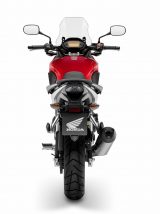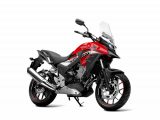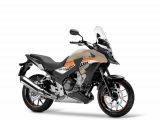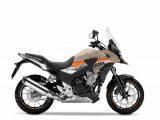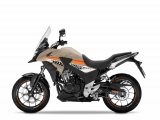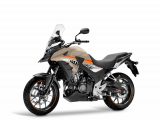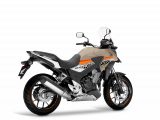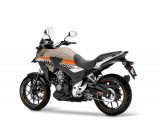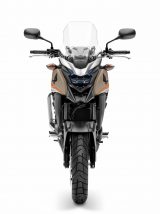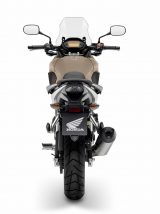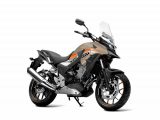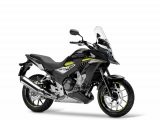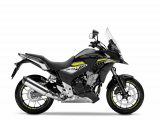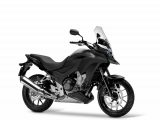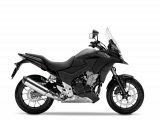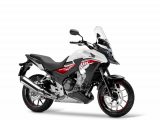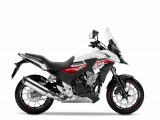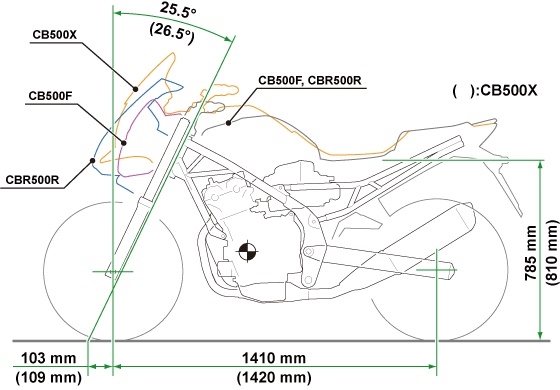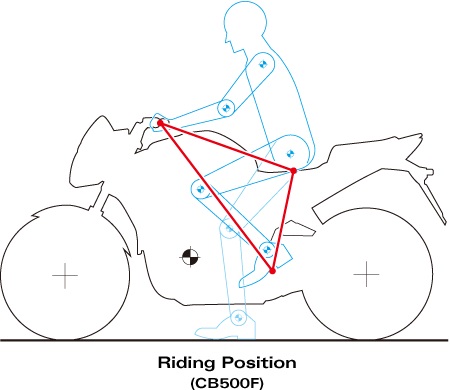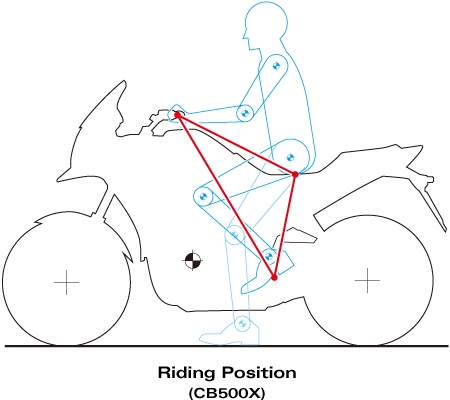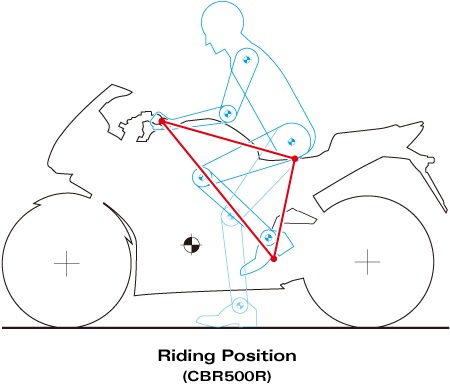– Detailed 2016 CB500X Review: Price, Accessories, HP & TQ, MPG + More! –
The CB500X is back again for 2016 as it should be because it’s been one of the better sellers out of the 500 cc trio from Honda that include the CBR500R sport bike, CB500F naked sport bike / streetfighter and the CB500X adventure bike that we’re covering here. The CB500X was first released back in 2013 and I’ve got to say I was rather surprised to see Honda was throwing some upgrades & changes at the CB500X so quickly. Typically, in Honda fashion we’ll see the BNG “Bold New Graphics” for a few years and then a slight tweak followed by more BNG and then it will receive some upgrades. The changes to the CB500X / CB500F / CBR500R are a good thing though as it means Honda wants to keep these bikes competitive when going up against Yamaha, Suzuki, Kawasaki etc. These changes don’t come free though as Honda did a slight price increase on the CB500X but you are still getting a lot of bang for your buck…
2016 CB500X Changes: The CB500X adventure motorcycle gets a major boost to its crossover style with improved wind protection thanks to being able to adjust the compact windscreen to varying heights (plus it’s 100mm taller this year), other upgrades include a larger fuel tank that is carefully shaped to give the rider an unrestricted riding position, restyled LED lighting with a new headlight and tailight, spring preload adjustable front forks and adjustable brake lever. a hinged fuel-tank filler cap, front suspension that’s now adjustable for spring preload, and a front-brake lever that’s adjustable too.
2017 CB500X Review – Click Here
CB500X Review Contents:
- 1. Introduction
- 2. Model Overview
- 3. Key Features
- 4. Pricing / MSRP
- 5. Development
- 6. Technical Specifications
1. Introduction
With its all-round punchy performance, adventure styling, affordable price point and low running costs the twin-cylinder CB500X is a great place from which to begin a lifelong motorcycling journey. Its upright, roomy riding position, substantial tank range and long-travel suspension inject a genuine sense of adventure into every ride, and make it serve equally well through the weekly commute as on the weekend escape.
Furthermore, its free-revving, flexible engine performance – with internal design derived from the CBR600RR and CBR1000RR – has gained approval not only from riders stepping up to an A2 licence overseas, but also from experienced motorcyclists looking for a fun, practical and economical all-rounder.
For 2016 CB500X evolves further, with enhanced crossover style, function and desirability to offer a compelling package of all-round capability with an adventurous spirit at an affordable price.
2. Model Overview
While its 471cc DOHC engine – producing 49.6 HP / 35kW and returning 71 MPG – and steel diamond-tube frame remain unchanged, the CB500X’s outlook is revised for 2016 with a much larger windscreen, and the premium touch of LED headlight and taillight.
A slightly larger fuel tank extends range, and detail improvements such as the hinged fuel cap, adjustable reach brake lever, redesigned seat and ‘wave’ style ignition key elevate the overall owning experience. The ride is improved with the addition of adjustable spring preload in the front forks, new damping rates for the rear shock and redesigned shift drum for smoother gear changes.
3. Key Features
3.1 Styling & Equipment
The CB500X in its original form struck a fine balance between a compact, easy-to-manage size and its ability to inspire discovery and cover distance in comfort. For this next step Honda’s engineers aimed to boost the instinctive sense of freedom to travel under the styling concept of ‘Feel the Adventure.’
The new LED headlight is physically small but powerful. Its angular outline is crowned by twin position lights and a silver finish on the bottom of the windscreen giving the CB500X a closer resemblance to Honda’s bigger X machines – the NC700X, NC750X, VFR800X Crossrunner and VFR1200X Crosstourer. Two-part side panels tie the front and rear design aspects together, and feature painted uppers. Black engine covers underpin the new design.
Extended upwards by approx. 100mm compared to the previous model, the redesigned windscreen offers greater wind and weather protection for the rider’s upper body and features a central duct to equalize pressure and reduce turbulence around the helmet. Two height positions are possible to adjust for rider preference.
Fuel capacity has grown to 4.6 gallons, extending tank range to over 320 miles per tank on the 2016 CB500X. Detail upgrades for rider benefit include a hinged fuel cap and 5-step adjustable span brake lever. A ‘wave’ key also has a smoother, more premium feel in use. The seat unit is finished with a clear-lensed rear LED light.
The comprehensive dash features a digital speedometer, digital bar graph tachometer, odometer, dual trip meters, clock, plus digital fuel level gauge and fuel consumption. HISS (Honda Intelligent Security System) is built in to the ignition on overseas models. There’s space under the seat to store a U-lock and a bash-plate is fitted to protect the engine underside and exhaust pipe on rough, loose surfaces.
2016 CB500X Colors:
- Matte Black Metallic (USA)
- Matte Brown Metallic (USA)
- Matt Fresco Brown
- Asteroid Black
- Millennium Red
- Pearl Horizon White
- Matt Gunpowder Black
3.2 Engine
The CB500X’s DOHC, 8-valve liquid-cooled parallel twin layout offers a great combination of compact physical size and flexible output. The ‘triangle’ proportion of crankshaft, main shaft and countershaft is very similar to that of Honda’s four-cylinder RR engines and much of the internal structure and engineering is taken directly from both the CBR600RR and CBR1000RR.
Bore and stroke is set at 67mm x 66.8mm; the crankshaft pins are phased at 180° and a primary couple-balancer sits behind the cylinders, close to the bike’s centre of gravity. The primary and balancer gears use scissor gears, reducing noise. The crank counterweight is specifically shaped for couple-balance and its light weight allows the engine to spin freely, with reduced inertia.
PGM-FI fuel injection provides superb throttle response; the gasflow route from airbox to exhaust is as straight as possible and a plate in the airbox separates the airflow to each cylinder. Peak horsepower of 49.6 arrives at 8,500 RPM, with 31.7 lb ft torque delivered at 7,000 RPM.
The engine acts as a stressed member, reinforcing the frame’s rigidity with four frame hangers on the cylinder head. Internally the cylinder head uses roller rocker arms; shim-type valve adjustment allows them to be light, for lower valve-spring load and reduced friction. A silent (SV Chain) cam chain has the surface of its pins treated with Vanadium, reducing friction with increased protection against dust. Inlet valve diameter is 26.0mm with exhaust valve diameter of 21.5mm.
Bore size of 67mm is identical to that of the CBR600RR. The piston shape is based upon those used in the CBR1000RR to reduce piston ‘noise’ at high rpm. Friction is reduced by the addition of striations on the piston skirt (a finish that increases surface area, introducing gaps in which oil can flow for better lubrication). As with the CBR600RR and CBR1000RR, an AB 1 salt bath process, used after isonite nitriding, forms a protective oxidisation membrane.
The crankcase uses centrifugally cast thin-walled sleeves, and the same bore interval as the CBR600RR helps them be as compact and light as possible. Their internal design reduces the ‘pumping’ losses that can occur with a 180° phased firing order. Using the same internal relief structure as that of the CBR1000RR, the oil pump features improved aeration performance, with reduced friction; a deep sump reduces oil movement under hard cornering and braking. Oil capacity is 3.4 quarts.
A six-speed gearbox mirrors that of its RR cousins which use the same gear change arm structure and link mechanism. In an update for 2016, the shift drum stopper spring load has been revised, along with the shape of the shift drum center, for smoother, easier gear changing.
- 2016 CB500X Horsepower Rating: 49.6 HP at 8,500 RPM
- 2016 CB500X Torque Rating: 31.7 lb ft TQ at 7,000 RPM
- 2016 CB500X MPG Rating: 71 Miles Per Gallon
3.3 Chassis
The CB500X’s 35mm diameter steel diamond-tube mainframe is light and strong, with a tuned degree of yield that gives plenty of feedback to the rider as road surfaces change. The shape and position of the engine mounts, plus the frame’s rigidity balance, reduces vibration.
Wheelbase is 1420mm and rake and trail are set at 26.5°/108mm giving an agile, yet composed steering feel. Mass centralization, with the engine in very close proximity to the swingarm pivot point, delivers turning agility and optimum front/rear weight distribution ensures stability. Curb weight comes in at 427 pounds for the 2016 CB500X.
Seat height is low at 810mm, making the CB500X very easy to manage and its sporty riding position will comfortably accommodate riders of varying heights thanks to a relatively high handlebar position. Overall dimensions are 2095mm x 830mm x 1360mm, with 170mm ground clearance.
For 2016 the 41mm telescopic front fork (with 140mm stroke) gains spring preload adjustment and alongside the Pro-Link rear shock – which has 5-step preload adjustment and revised damping rates – offers the rider flexibility to adjust for loads. Final drive is via 520 sealed chain.
Lightweight, 17-inch cast aluminium wheels employ hollow cross-section Y-shaped spokes. Front wheel width is 3.5 inch; the rear 4.5 inch and tires are 120/70-ZR17 and 160/60-ZR17. A single front 320mm wavy disc and two-piston brake caliper is matched to a 240mm rear disc and single-piston caliper. ABS is fitted as standard.
4. 2016 Honda CB500X Pricing Update
- 2016 CB500X Price / MSRP: $6,499
- 2016 CB500X ABS Price / MSRP: $6,799
In the past, ABS has set you back $500 with Honda on the CB500X. In 2015 the CB500X standard model was $6,299 while the ABS brought the tally up to $6,799. I’d say ABS sales for the CB500X will rise as a lot of customers I’ve dealt with didn’t want to pony up and pay the extra $500 tab for the added safety. This will be the second price increase for the CB500X as it originally started out with an MSRP of $5,999 in 2013 shortly followed by the bump to $6,299. It’s still priced right though and bang for the buck you’ll have a difficult time finding anything to beat it. Especially when you start comparing MPG numbers and maintenance costs etc. That’s where the CB500X really shines when you look at the complete cost of ownership picture.
5. Honda CB500X Development Story (Including CBR500R / CB500F)
There’s a whole new generation of young riders looking to enter the sport of motorcycling on bikes that are fun to ride, nimble and easy to handle, affordable and economical to operate, plus distinctive in appearance. For this set of buyers, Honda has hit a grand slam by creating a trio of modern-era 500cc machines that redefine the middleweight category. These three bikes take aim at three popular styles of bikes that resonate with their own identity, yet all are filled with Honda quality and value, through and through.
First, there’s the CBR500R, a lightweight and nimble middleweight sport bike that’s just right for riders moving up in displacement categories, as well as for experienced riders who just love riding a great-handling bike. Next, there’s the CB500F naked sport bike, a great choice for independent-minded riders in search of a mid-sized entry-level bike with extra attitude, but one that’s also a great daily ride. And there’s also a middleweight adventure-style bike, the CB500X, a bike that follows the lead of the popular NC700X introduced in 2012. For riders who want to add a smaller, lighter and eminently affordable adventure-style bike to their lives, the CB500X is just the ticket.
Each of these brand-new models has its own look and personality plus a tie-in to larger bikes in the Honda lineup, and they also share that distinctive, high-quality Honda feel. Despite their unique appearances, these three bikes share the same basic chassis components and engine—a smart move, since sharing common elements helps reduce development and production costs, resulting in a markedly lower consumer price point.
CBR500R
As its name suggests, the CBR500R features full bodywork much like that found on the potent CBR600RR and CBR1000RR Honda sportbikes. Sportbike riders, whether well established in the sport or still developing their motorcycling skills, always prize the excellent handling traits that come with a light and responsive mount. And the new, lightweight and nimble CBR500R absolutely delivers in that department—there’s plenty of well-rounded performance on tap here. It’s just the right size for sport riders moving up from the entry-level Honda CBR250R, but even experienced sportbike riders will appreciate the handling characteristics of this 425-pound bike. Its aerodynamic bodywork provides significant advantages in air management for added rider comfort, along with a low drag coefficient and effective engine cooling, rounding out a package that looks as good as it works.
CB500F
Naked sport bikes form another distinct category of motorcycling, one that fosters the image of independence and non-conformity. And that’s especially true with the CB500F, a bike that looks like a first-cousin to the liter-sized CB1000R. This modern and sporty 500cc naked bike not only carries a full load of attitude and style, it also delivers plenty of performance and versatility. Tipping the scales at only 420 pounds, it’s got everything you need, and nothing that you don’t. Whether it’s used as a daily commuter machine, an affordable weekend ride for backroad day trips, or a bike for hanging out at the local gathering spot, the CB500F serves as a great option for just about any kind of street use. Its comfortable, neutral riding position and slim profile let riders feel right at home in the saddle. For a bike that’s affordable, stylish and fun, it’s tough to top the new CB500F.
CB500X
We all understand that half the fun of motorcycling is the mental escape it provides when you’re tied down at the 9 to 5 job. For riders who love to dream about getting far away on a ride, the middleweight CB500X is a fantastic option that follows in the tire prints of the recently introduced and highly acclaimed NC700X adventure-style bike. This is a bike that begs to travel new roads and discover new sights, a fun-to-ride motorcycle with an extra dose of versatility. The compact windscreen can be adjusted in height, and it also has a comfortable adventure-bike seating position, plus a larger-capacity fuel tank that has been carefully shaped to allow the rider unrestricted movement. It features a longer-stroke 41mm front fork that produces 4.9 inches of travel, and a wider handlebar allows for easy steering inputs. And while this the CB500X works well for longer-range adventure tours, it also serves as a versatile ride to fulfill those everyday needs too. For riders seeking a little more adventure in their lives, the CB500X delivers on that idea at a very affordable price.
Engine Technology
Regardless of market placement, all three bikes share an all-new engine and Honda’s engineers decided that a sleek parallel twin would serve best to generate sufficient torque in the low-rpm range to produce the kind of fun, easily accessible powerband that is a hallmark of all three bikes. And so this series of bikes became 500cc liquid-cooled parallel twins with a bore and stroke configuration of 67 x 66.8mm. The stroke of 66.8mm was the maximum possible, given the compact engine dimensions the engineers had also set as a priority. The 7mm bore interval in this engine is the same as the bore intervals in the CBR600RR; this tight distance results in a compact—and light weight—engine.
The valvetrain incorporates four valves per cylinder actuated by dual overhead camshafts. The intake valves measure 26mm in diameter, the exhaust valves 21.5mm, and narrow valve stems help reduce reciprocating weight and engine friction. This DOHC configuration was chosen for higher performance; it gave the engineering team greater latitude in developing the shape of the combustion chamber, the shape of the ports and the layout angle of the valves, while also allowing the use of lighter valves. Careful attention was paid in particular to creating a markedly straight-line flow from the air cleaner through the intake ports and out the exhaust pipe to maximize efficiency.
The cylinder head design also incorporates a roller rocker arm for a more compact layout along with reduced friction. The choice of a shim-type valve adjustment system allowed incorporation of a lighter rocker arm setup that, in turn, allowed for a lower valve-spring load to further reduce power losses through engine friction. The cams are driven by a silent-type cam chain for reduced engine friction, and the surfaces of the cam-chain pins are treated with vanadium for lower friction and increased toughness. Compression ratio is set at 10.7:1, and to reduce piston noise and friction at the relatively high top engine speeds slated for these bikes (redline is 8600 rpm and rev-cut occurs at 9100 rpm), the short 67mm piston features asymmetrical skirts that are the same length but differ in width. Using technology applied to the CBR600RR, striations on the piston skirts aid oil retention for better lubrication, and the piston pins and connecting rods are also treated with a friction-reducing special protective coating. The 180-degree crankpin design and an engine counterbalancer help smooth operation, and preloaded scissor gears are used for the primary and balancer gears to reduce gear whine/engine noise. All in all, a sophisticated package.
A six-speed gearbox complements the power output of this engine, and the triangulated layout between crankshaft, mainshaft and countershaft is very similar to that of the four-cylinder CBR-RR engines, which aids in creating a very compact unit. Engine weight, at 116 pounds, is laudably light. In addition, the gear-change mechanism uses the same gearshift structure and gearshift link design used in the ultra-high-performance CBR600RR and CBR1000RR sport bikes to yield high-quality shifting action and feel.
Honda’s Programmed Fuel Injection (PGM-FI) system delivers the appropriate fuel mixture according to existing riding and atmospheric conditions for crisp throttle response. A pair of 34mm throttle bodies feed the engine, with the injectors located within the throttle-body assembly. All of this technology helps give all three 500s an especially responsive, revvy nature and a high-quality feel.
Chassis Technology
The engine hangs as a stressed frame member housed in a monocoque frame evocative of Honda’s MotoGP racing machines. The cylinder head features four solid attachment points for engine hangers, which allows the rigidity of the engine to add to chassis rigidity. Such a design lends itself to a more simplified frame shape, yielding a more lightweight and compact chassis. The resulting frame is a diamond-shaped unit with a 35mm steel tube main member, and the final design is significantly lighter than other comparable designs, which adds greatly to the handling prowess of all three bikes.
The CBR500R and CB500F share the same wheelbase of 55.5 inches, while the CB500X spans 55.9 inches between axles. The X model also has one degree more steering rake than its two siblings (26° 5′ versus 25° 5′), and its 41mm fork yields 4.9 inches of travel in contrast to the 4.3 inches of fork travel with the other two bikes. All three share the same Pro-Link® single-shock rear suspension system, which offers nine-step cam-style spring preload adjustability and 4.7 inches of travel. Thanks in part to this slightly taller suspension setup the CB500X seat is slightly taller at 31.9 inches, versus 30.9 inches for the CBR500R and CB500F. Even so, the CB500X seat is perched nearly an inch lower than that of the larger NC700X adventure-style bike, which makes it distinctly more friendly feeling for riders with shorter inseams.
All three models share the same lightweight cast aluminum wheels, a 120/70-17 front and 160/60-17 rear. These wheels follow the designs used for the latest CBR600RR and CBR1000RR wheels. The brake setups are likewise identical among all three 500s: a twin-piston caliper and 320mm wave-style disc up front, and a 240mm wave disc in back. The front brake in particular offers excellent stopping power and feel. The wave design reduces unsprung weight and it also offers excellent heat-dissipating qualities. ABS is an option with all three bikes and the ABS systems are independent, not linked, between the rear and front brakes.
So there you have it: three different bikes, three different riding experiences for three different kinds of riders. But all three bikes are lightweight, nimble and fun to ride, and each one possesses a level of quality and sophistication that makes it a fantastic value for the money.
Honda CB500X / CBR500R / CB500F Model Lineup Pictures
6. 2016 CB500X Technical Specifications
| ENGINE | |
| Type | Liquid-Cooled, parallel twin |
| Displacement | 471cc |
| Bore and stroke | 67mm x 66.8mm |
| Compression Ratio | 10.7 : 1 |
| Max. Power Output | 49.6 HP (35kW) @ 8500rpm |
| Max. Torque | 31.7 lb/ft TQ (43Nm) @ 7000rpm |
| Oil Capacity | 3.38 qt (3.2L) |
| FUEL SYSTEM | |
| Induction | PGM FI |
| Fuel Tank Capacity | 4.4 gal (17.5L) (inc reserve) |
| Fuel Consumption(WMTC) | 71 MPG (29.4km/liter) |
| ELECTRICAL SYSTEM | |
| Starter | Motor |
| Battery Capacity | 12V 8.6AH |
| ACG Output | 23.4A/2000rpm |
| DRIVETRAIN | |
| Clutch Type | Wet multiplate |
| Transmission Type | 6 speed |
| Final Drive | Chain |
| FRAME | |
| Type | Steel, Diamond |
| CHASSIS | |
| Dimensions (L´W´H) | 82.4 x 32.6 x 53.5 in (2095mm x 830mm x 1360mm) (Low screen) 54.7 in / 1390mm (Hi screen) |
| Wheelbase | 55.9 in (1420mm) |
| Caster Angle | 26.5 degrees |
| Trail | 108mm |
| Seat Height | 31.8 in (810mm) |
| Ground Clearance | 6.6 in (170mm) |
| Curb Weight | 427.6 lbs (196kg) |
| SUSPENSION | |
| Type Front | Conventional Telescopic, 41mm, pre-load adjustable |
| Type Rear | Prolink mono with 9 stage Preload adjuster, steel square pipe swingarm |
| WHEELS | |
| Type Front | Multi-Spoke Aluminium Cast |
| Type Rear | Multi-Spoke Aluminium Cast |
| Rim Size Front | 17 X MT3.5 |
| Rim Size Rear | 17 X MT4.5 |
| Tires Front | 120/70ZR – 17M/C (On-Off Pattern) |
| Tires Rear | 160/60ZR – 17M/C (On-Off Pattern) |
| BRAKES | |
| ABS System Type | 2-Channel |
| Type Front | Single Wave Disk, 320mm, 2 POT caliper |
| Type Rear | Single Wave Disk, 240mm, 1 POT caliper |
| INSTRUMENTS & ELECTRICS | |
| Instruments | Digital Speedometer, Digital Bar Graph Tachometer, Dual Trip Meters, Digital Fuel Level Gauge & Fuel Consumption Gauge, Digital Clock |
| Security System | HISS (Honda Intelligent Security System) European models |
| Headlight | Low 4.8W, Hi 12W x 1 light |

